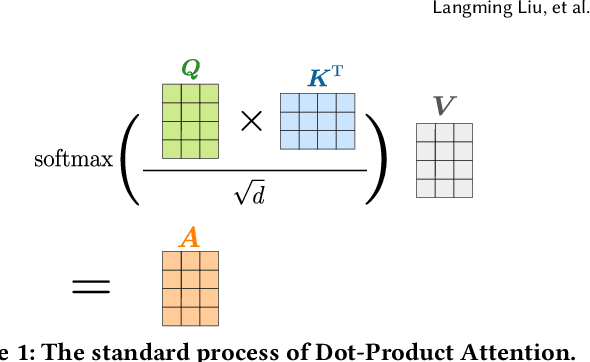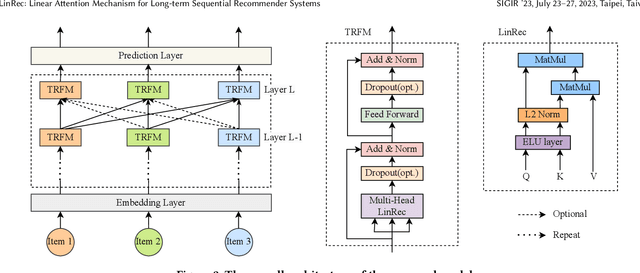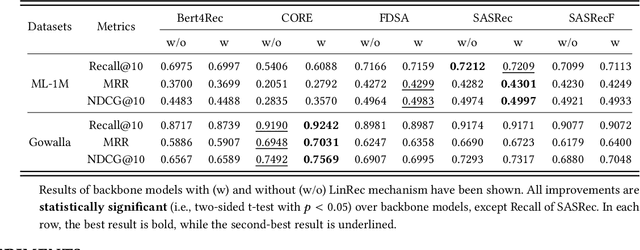Wanyu Wang
Model Merging for Knowledge Editing
Jun 14, 2025Abstract:Large Language Models (LLMs) require continuous updates to maintain accurate and current knowledge as the world evolves. While existing knowledge editing approaches offer various solutions for knowledge updating, they often struggle with sequential editing scenarios and harm the general capabilities of the model, thereby significantly hampering their practical applicability. This paper proposes a two-stage framework combining robust supervised fine-tuning (R-SFT) with model merging for knowledge editing. Our method first fine-tunes the LLM to internalize new knowledge fully, then merges the fine-tuned model with the original foundation model to preserve newly acquired knowledge and general capabilities. Experimental results demonstrate that our approach significantly outperforms existing methods in sequential editing while better preserving the original performance of the model, all without requiring any architectural changes. Code is available at: https://github.com/Applied-Machine-Learning-Lab/MM4KE.
* 11 pages, 3 figures
Training-free LLM Merging for Multi-task Learning
Jun 14, 2025Abstract:Large Language Models (LLMs) have demonstrated exceptional capabilities across diverse natural language processing (NLP) tasks. The release of open-source LLMs like LLaMA and Qwen has triggered the development of numerous fine-tuned models tailored for various tasks and languages. In this paper, we explore an important question: is it possible to combine these specialized models to create a unified model with multi-task capabilities. We introduces Hierarchical Iterative Merging (Hi-Merging), a training-free method for unifying different specialized LLMs into a single model. Specifically, Hi-Merging employs model-wise and layer-wise pruning and scaling, guided by contribution analysis, to mitigate parameter conflicts. Extensive experiments on multiple-choice and question-answering tasks in both Chinese and English validate Hi-Merging's ability for multi-task learning. The results demonstrate that Hi-Merging consistently outperforms existing merging techniques and surpasses the performance of models fine-tuned on combined datasets in most scenarios. Code is available at: https://github.com/Applied-Machine-Learning-Lab/Hi-Merging.
* 14 pages, 6 figures
KAITIAN: A Unified Communication Framework for Enabling Efficient Collaboration Across Heterogeneous Accelerators in Embodied AI Systems
May 15, 2025Abstract:Embodied Artificial Intelligence (AI) systems, such as autonomous robots and intelligent vehicles, are increasingly reliant on diverse heterogeneous accelerators (e.g., GPGPUs, NPUs, FPGAs) to meet stringent real-time processing and energy-efficiency demands. However, the proliferation of vendor-specific proprietary communication libraries creates significant interoperability barriers, hindering seamless collaboration between different accelerator types and leading to suboptimal resource utilization and performance bottlenecks in distributed AI workloads. This paper introduces KAITIAN, a novel distributed communication framework designed to bridge this gap. KAITIAN provides a unified abstraction layer that intelligently integrates vendor-optimized communication libraries for intra-group efficiency with general-purpose communication protocols for inter-group interoperability. Crucially, it incorporates a load-adaptive scheduling mechanism that dynamically balances computational tasks across heterogeneous devices based on their real-time performance characteristics. Implemented as an extension to PyTorch and rigorously evaluated on a testbed featuring NVIDIA GPUs and Cambricon MLUs, KAITIAN demonstrates significant improvements in resource utilization and scalability for distributed training tasks. Experimental results show that KAITIAN can accelerate training time by up to 42% compared to baseline homogeneous systems, while incurring minimal communication overhead (2.8--4.3%) and maintaining model accuracy. KAITIAN paves the way for more flexible and powerful heterogeneous computing in complex embodied AI applications.
STAR-Rec: Making Peace with Length Variance and Pattern Diversity in Sequential Recommendation
May 06, 2025Abstract:Recent deep sequential recommendation models often struggle to effectively model key characteristics of user behaviors, particularly in handling sequence length variations and capturing diverse interaction patterns. We propose STAR-Rec, a novel architecture that synergistically combines preference-aware attention and state-space modeling through a sequence-level mixture-of-experts framework. STAR-Rec addresses these challenges by: (1) employing preference-aware attention to capture both inherently similar item relationships and diverse preferences, (2) utilizing state-space modeling to efficiently process variable-length sequences with linear complexity, and (3) incorporating a mixture-of-experts component that adaptively routes different behavioral patterns to specialized experts, handling both focused category-specific browsing and diverse category exploration patterns. We theoretically demonstrate how the state space model and attention mechanisms can be naturally unified in recommendation scenarios, where SSM captures temporal dynamics through state compression while attention models both similar and diverse item relationships. Extensive experiments on four real-world datasets demonstrate that STAR-Rec consistently outperforms state-of-the-art sequential recommendation methods, particularly in scenarios involving diverse user behaviors and varying sequence lengths.
A Survey of Personalization: From RAG to Agent
Apr 14, 2025Abstract:Personalization has become an essential capability in modern AI systems, enabling customized interactions that align with individual user preferences, contexts, and goals. Recent research has increasingly concentrated on Retrieval-Augmented Generation (RAG) frameworks and their evolution into more advanced agent-based architectures within personalized settings to enhance user satisfaction. Building on this foundation, this survey systematically examines personalization across the three core stages of RAG: pre-retrieval, retrieval, and generation. Beyond RAG, we further extend its capabilities into the realm of Personalized LLM-based Agents, which enhance traditional RAG systems with agentic functionalities, including user understanding, personalized planning and execution, and dynamic generation. For both personalization in RAG and agent-based personalization, we provide formal definitions, conduct a comprehensive review of recent literature, and summarize key datasets and evaluation metrics. Additionally, we discuss fundamental challenges, limitations, and promising research directions in this evolving field. Relevant papers and resources are continuously updated at https://github.com/Applied-Machine-Learning-Lab/Awesome-Personalized-RAG-Agent.
Breaking Shallow Limits: Task-Driven Pixel Fusion for Gap-free RGBT Tracking
Mar 14, 2025Abstract:Current RGBT tracking methods often overlook the impact of fusion location on mitigating modality gap, which is key factor to effective tracking. Our analysis reveals that shallower fusion yields smaller distribution gap. However, the limited discriminative power of shallow networks hard to distinguish task-relevant information from noise, limiting the potential of pixel-level fusion. To break shallow limits, we propose a novel \textbf{T}ask-driven \textbf{P}ixel-level \textbf{F}usion network, named \textbf{TPF}, which unveils the power of pixel-level fusion in RGBT tracking through a progressive learning framework. In particular, we design a lightweight Pixel-level Fusion Adapter (PFA) that exploits Mamba's linear complexity to ensure real-time, low-latency RGBT tracking. To enhance the fusion capabilities of the PFA, our task-driven progressive learning framework first utilizes adaptive multi-expert distillation to inherits fusion knowledge from state-of-the-art image fusion models, establishing robust initialization, and then employs a decoupled representation learning scheme to achieve task-relevant information fusion. Moreover, to overcome appearance variations between the initial template and search frames, we presents a nearest-neighbor dynamic template updating scheme, which selects the most reliable frame closest to the current search frame as the dynamic template. Extensive experiments demonstrate that TPF significantly outperforms existing most of advanced trackers on four public RGBT tracking datasets. The code will be released upon acceptance.
Scenario-Wise Rec: A Multi-Scenario Recommendation Benchmark
Dec 23, 2024Abstract:Multi Scenario Recommendation (MSR) tasks, referring to building a unified model to enhance performance across all recommendation scenarios, have recently gained much attention. However, current research in MSR faces two significant challenges that hinder the field's development: the absence of uniform procedures for multi-scenario dataset processing, thus hindering fair comparisons, and most models being closed-sourced, which complicates comparisons with current SOTA models. Consequently, we introduce our benchmark, \textbf{Scenario-Wise Rec}, which comprises 6 public datasets and 12 benchmark models, along with a training and evaluation pipeline. Additionally, we validated the benchmark using an industrial advertising dataset, reinforcing its reliability and applicability in real-world scenarios. We aim for this benchmark to offer researchers valuable insights from prior work, enabling the development of novel models based on our benchmark and thereby fostering a collaborative research ecosystem in MSR. Our source code is also publicly available.
Stepwise Reasoning Error Disruption Attack of LLMs
Dec 16, 2024



Abstract:Large language models (LLMs) have made remarkable strides in complex reasoning tasks, but their safety and robustness in reasoning processes remain underexplored. Existing attacks on LLM reasoning are constrained by specific settings or lack of imperceptibility, limiting their feasibility and generalizability. To address these challenges, we propose the Stepwise rEasoning Error Disruption (SEED) attack, which subtly injects errors into prior reasoning steps to mislead the model into producing incorrect subsequent reasoning and final answers. Unlike previous methods, SEED is compatible with zero-shot and few-shot settings, maintains the natural reasoning flow, and ensures covert execution without modifying the instruction. Extensive experiments on four datasets across four different models demonstrate SEED's effectiveness, revealing the vulnerabilities of LLMs to disruptions in reasoning processes. These findings underscore the need for greater attention to the robustness of LLM reasoning to ensure safety in practical applications.
Pre-train, Align, and Disentangle: Empowering Sequential Recommendation with Large Language Models
Dec 05, 2024Abstract:Sequential recommendation (SR) aims to model the sequential dependencies in users' historical interactions to better capture their evolving interests. However, existing SR approaches primarily rely on collaborative data, which leads to limitations such as the cold-start problem and sub-optimal performance. Meanwhile, despite the success of large language models (LLMs), their application in industrial recommender systems is hindered by high inference latency, inability to capture all distribution statistics, and catastrophic forgetting. To this end, we propose a novel Pre-train, Align, and Disentangle (PAD) paradigm to empower recommendation models with LLMs. Specifically, we first pre-train both the SR and LLM models to get collaborative and textual embeddings. Next, a characteristic recommendation-anchored alignment loss is proposed using multi-kernel maximum mean discrepancy with Gaussian kernels. Finally, a triple-experts architecture, consisting aligned and modality-specific experts with disentangled embeddings, is fine-tuned in a frequency-aware manner. Experiments conducted on three public datasets demonstrate the effectiveness of PAD, showing significant improvements and compatibility with various SR backbone models, especially on cold items. The implementation code and datasets will be publicly available.
LinRec: Linear Attention Mechanism for Long-term Sequential Recommender Systems
Nov 03, 2024



Abstract:Transformer models have achieved remarkable success in sequential recommender systems (SRSs). However, computing the attention matrix in traditional dot-product attention mechanisms results in a quadratic complexity with sequence lengths, leading to high computational costs for long-term sequential recommendation. Motivated by the above observation, we propose a novel L2-Normalized Linear Attention for the Transformer-based Sequential Recommender Systems (LinRec), which theoretically improves efficiency while preserving the learning capabilities of the traditional dot-product attention. Specifically, by thoroughly examining the equivalence conditions of efficient attention mechanisms, we show that LinRec possesses linear complexity while preserving the property of attention mechanisms. In addition, we reveal its latent efficiency properties by interpreting the proposed LinRec mechanism through a statistical lens. Extensive experiments are conducted based on two public benchmark datasets, demonstrating that the combination of LinRec and Transformer models achieves comparable or even superior performance than state-of-the-art Transformer-based SRS models while significantly improving time and memory efficiency.
 Add to Chrome
Add to Chrome Add to Firefox
Add to Firefox Add to Edge
Add to Edge